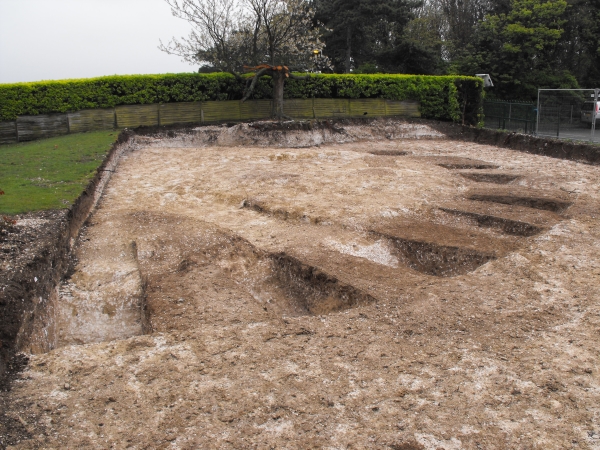
The image for Day 231 of the VM_365 project is of the portion of the ring ditch of a round barrow which was excavated at Bradstow School, Broadstairs in 2009. The image shows the regular series of segments taken out of the fill of the ring ditch to reveal sections at intervals around the circuit.
The ring ditch is one of a group of four similar ring ditches which are distributed around the terminal of a dry valley where it meets the east facing aspect of a rounded chalk-downland hill, now occupied by the extensive grounds of the Bradstow school, formerly a private House called Valletta House.
The Bronze Age landscape of the hilltop has been revealed in a remarkably extended series of investigations that began with an excavation carried out in 1910 by Howard Hurd, who featured in the post for Day 40. Hurd revealed a double ring ditch, probably representing a barrow that had been extended or refurbished at some time during its period of use as a funerary monument. Two further ring ditches were recorded in excavations carried out by the Broadstairs and St.Peters Archaeological Society (BSPAS) with the assistance of the British Museum (BM), to the west and south west of Hurd’s excavation.
The construction of a new facility for Bradstow School within part of the playing field in 2006, resulted in the discovery and excavation of a very large causewayed ring ditch, which may have been a ceremonial enclosure rather than a funerary monument like those that had been discovered by the earlier work. Nearby an unusually small ring ditch contained four graves, an unusual feature that does not fit into the conventional classifications of prehistoric burials in Thanet.
When a former garden site standing immediately adjacent to the western most of the ring ditches recorded in the BSPAS and BM excavations was chosen as the location of a new swimming pool for the School, there was a further opportunity to explore the Bronze Age landscape of this Broadstairs hill top. Evaluation trenches revealed the circuit of another ring ditch, which was partly excavated before the pool was built. This excavation was carried out nearly a century after Howard Hurd’s discovery of the barrow under the lawns of Valleta House.
The centre of the barrow where a primary burial might be expected was not exposed in the excavation. Two rectangular graves were associated with the ring ditch, one within the circuit which was severely truncated and contained no human remains. The other grave was perhaps inserted on the periphery of the barrow at a later date, it contained the remains of a child, lying crouched on its left hand side facing south, with a collared urn placed as an accessory vessel on the southern side of the skull.
The ring ditch excavated in 2009, which had a diameter of approximately 24m continued the linear series of barrows that line the edge of the arc that is formed by the intersection of the dry valley with the hill top. Each point around the arc commanded a vista across the lower lying land and the sea, which may have been an important factor in the choice of location for these burial mounds in the Bronze Age and of the large causewayed ring ditch which stood very near to them.
3 thoughts on “VM_365 Day 231 Round barrow at Bradstow School, Broadstairs”